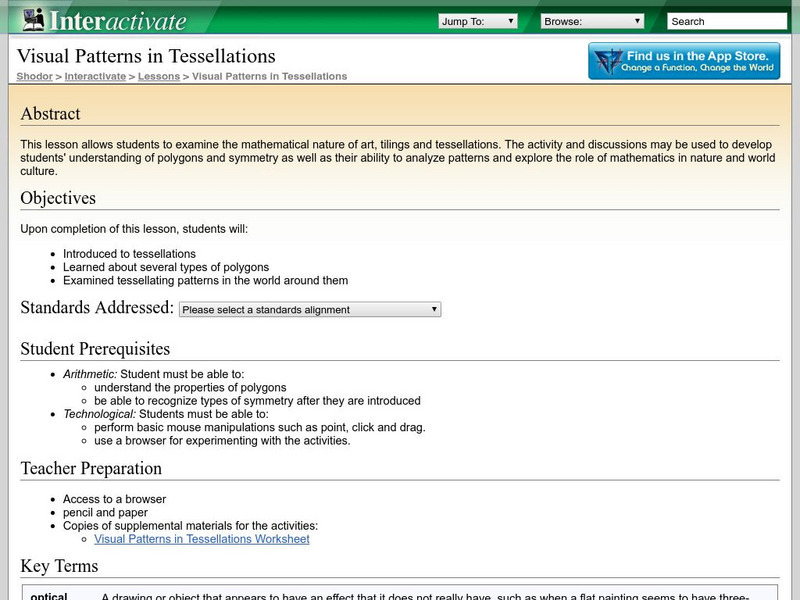Hi, what do you want to do?
Curated OER
Mosaics of Cyprus
Students create digital mosaics. In this visual arts lesson, students discover the attributes and history of mosaics in a teacher-led discussion. Students use an educational program to make their own digital mosaics.
Curated OER
Truly Terrific Tessellations
Third graders discover how the use of pattern is evident in dance, math, and visual art. They create a tessellation pattern, as well as a square dance that show an understanding of the principles of design (balance, repetition, rhythm,...
Curated OER
Mosaic Pavement Panel
Young scholars analyze Mosaic art and identify the tessellation process. In this Mosaic art lesson, students read information about Mosaic art and the tessellation process. Young scholars compare mosaics from various civilizations and...
Curated OER
Why is this lesson constructivist?
Learners formulate a definition of tessellations by comparing and contrasting different patterns and shapes of real objects. They discuss the relatioship between shapes and patterns as well as their function in the real world. Students...
Curated OER
Architecture
Students study tessellations and the work of M.C. Escher. They discuss the terminology of architecture, the historical significance of architecture in different parts of the world, and create their own piece of architecture out of...
Curated OER
Terrific Tessellations
Students create, transform, and critique their own piece of artwork. In doing this lesson, students get more experience working with angles, lines, and measurement. They gain experience seeing, and creating their own patterns and shapes.
National Gallery of Canada
My Upside-Down World!
M.C. Escher is famous for creating optical illusions. Examine this effect in several of his works and discuss the techniques involved. Inspired by the discussion, learners create an imaginary 3-D world inside of a box using various...
Incredible Art
1, 2, and 3-Point Perspective
Introduce drawing students to perspective with a series of lesson that detail how to draft images in one-, two-, and three-point perspective. Each exercise includes step-by-step, illustrated directions and examples.
Curated OER
Piece by Piece
Put an insect together piece by piece with a fun and artistic puzzle project. To increase small group collaboration, learners use photos of insects cut into one-inch squares to create an enlarged puzzle version of the image. Extension...
Curated OER
M. C. Escher - Design - Math Integration
Students create a tessellations using rotation and translation. They also create a tessellation using reflection.
Curated OER
Mandala Art
Students investigate art elements such as color schemes and proportion by creating their own personal Mandala Circle on paper or canvas. This also allows students to investigate mathematical concepts such as tesselations or social...
Curated OER
Vasarely Was A Colorful Fellow
Eighth graders create artwork inspired by the work of Victor Vasarely. In this op art lesson, 8th graders explore color theory and color mixing. Students create ten shapes to use in their artwork and over the course of two weeks,...
Curated OER
Let's Tesselate
Students investigate the geometrical concepts of translation, reflection, and rotation. They make different observations looking for the concepts that are displayed in classroom items like floor tiles, carpet designs, and visuals hung in...
Curated OER
Symmetry: Theory, Reality and Art!
Pupils explore the concept of geometric symmetry. In this geometric symmetry lesson, students walk around their school and take pictures of objects that demonstrate symmetry. Pupils use Microsoft Paint to draw the lines of symmetry on...
Curated OER
Batlik- Art of Japan
Eighth graders will examine the use of Japanese ar tforms. The paper lantern is the example drawn from for learners to connect with the culture. The end result is a creative project that should reflect the culture of Japan.
Curated OER
Personal Clay Box
Seventh graders discover how to assemble and finish a lidded box-like form from slabs of clay between soft and leather hard. They gain an appreciation for ceramic art.
Curated OER
Geometry and Symmetry
Students examine tessellations and their geometric properties. The lesson plan and discussions may be used to develop students' understanding of polygons and symmetry as well as their ability to analyze patterns.
Curated OER
Doorways/Printmaking
Middle schoolers are introduced to the techniques used in printmaking along with the relief method and tessellation relationships to art. In groups, they examine a variety of architecture used throughout the Islamic culture. To end the...
Curated OER
Expressive Linear Sculpture
Learners develop skill in utilizing line in a 3 dimensional context. They explore a variety of techniques for mounting sculptures to a base.
Curated OER
Exploring All Frontiers
Young scholars utilize higher thinking skills to expand their self concept to include physical, cognitive, and affective frontiers. The teacher create activities which allow students to use raw data and primary sources, as well as...
Curated OER
Minerals
Students explore the concept of minerals. In this minerals lesson, students discuss how cooling affects the size of crystals. Students discuss how the structure of minerals is a tetrahedron. Students discuss the structure of silicates...
Shodor Education Foundation
Shodor Interactivate: Lesson: Visual Patterns in Tessellations
This upper elementary and middle school lesson plan examines the mathematical nature of art, tilings and tessellations. Students will also explore polygons, symmetry, analyze patterns and explore the role of mathematics in nature and our...
PBS
Pbs: Mathline: Tessellations Wow! [Pdf]
An integrated geometry instructional activity on spatial sense in which students identify and use different shapes to create a tessellation. "Through a variety of modalities such as writing, music, art, poetry, and literature, students...




























![Pbs: Mathline: Tessellations Wow! [Pdf] Lesson Plan Pbs: Mathline: Tessellations Wow! [Pdf] Lesson Plan](https://static.lp.lexp.cloud/images/attachment_defaults/resource/large/FPO-knovation.png)